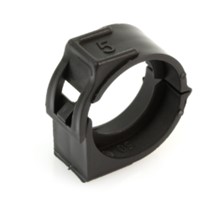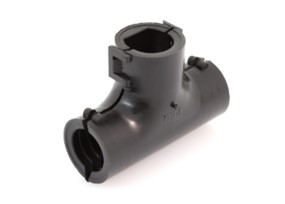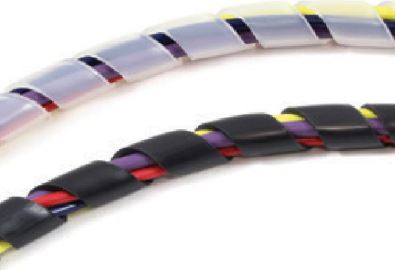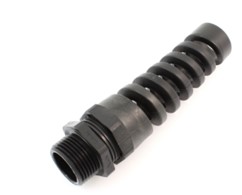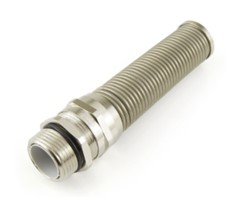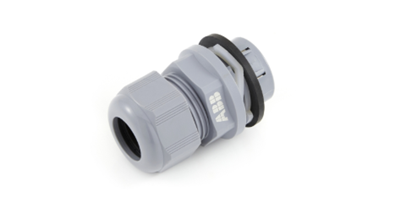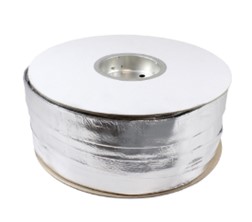Wire Harness Protection 101
Automotive wire harnesses in rugged vehicles—such as emergency, construction, marine, work trucks, and agricultural equipment—face extreme environmental conditions. These harnesses must withstand exposure to abrasion, mechanical stress, moisture, chemicals, and heat. Proper protection is critical to ensuring durability, reliability, and safety.
Here are four critical strategies that wire harness manufacturers, upfitters, and repair technicians should apply when designing and maintaining wire harnesses in these demanding applications.
1-Prevent Abrasion
Prevent abrasion in your harness wires and cables by keeping them properly protected and covered.
The most inexpensive and widely used way to cover wires is to run them through corrugated loom. This can be an excellent choice for work trucks and off-road vehicles, where vibration 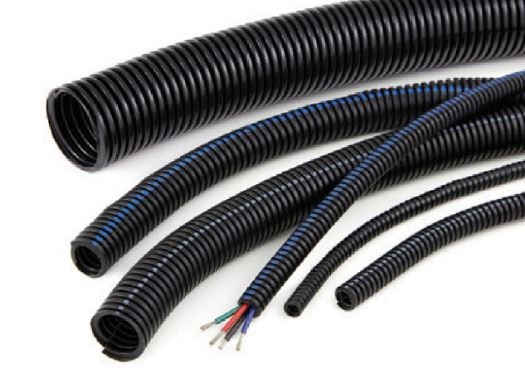 and chafing are constant threats. Corrugated loom provides a good balance of protection and flexibility, safeguarding wiring from sharp edges, vibration, and wear. It is easy to secure with loom fittings and provides a clean design.
and chafing are constant threats. Corrugated loom provides a good balance of protection and flexibility, safeguarding wiring from sharp edges, vibration, and wear. It is easy to secure with loom fittings and provides a clean design.
Right: Corrugated loom in various sizes, manufactured by Drossbach.
Loom fittings and clips will help secure bundles along their intended paths, reducing movement and stress on the wires. Loom fittings and clips prevent sagging and vibration-induced wear and abrasion. They come in various designs to suit different mounting locations and requirements.
Below: A conduit clip (left) and Tee style fitting (right) for corrugated loom, both made by Aptiv.
Spiral wrap tubing (shown below) is another great way to cover automotive wiring and cable assemblies. Spiral wrap tubing is slit so breakout wires in a harness assembly can exit through the wrap.
Braided sleeving is a wire covering option that is ideal for harnesses subjected to frequent movement such as those in construction and marine applications. Braided sleeving is expandable, making it ideal for covering wires and connectors of varying thicknesses. Expandable braided sleeving can be temporarily removed to allow for wire maintenance or repair. It will contract snugly back into place when returned to position over the wiring.
Below: Flexo® PET expandable braided sleeving made by Techflex. It expands to nearly 2 times its nominal diameter for easing installation over large plugs and connectors.
Fabric sleeving is another option for lightweight wire protection in tight spaces, reducing wear without sacrificing durability. Although fabric sleeving is not expandable, it is flexible and easy to use.
One of the most vulnerable areas of any harness is where wires pass through metal panels or other structures. To prevent chafing and insulation damage, bushings and grommets are essential, providing a protective cushion that absorbs vibration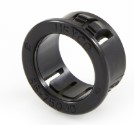 and isolates sharp edges. Bushings cushion wiring where it passes through metal openings, preventing sharp edges from cutting insulation.
and isolates sharp edges. Bushings cushion wiring where it passes through metal openings, preventing sharp edges from cutting insulation.
Shown at right: A snap bushing with a 5/8” inside diameter, made by Heyco.
Grommets provide a flexible, sealed entry point for wires through panels or bulkheads. Rubber and silicone grommets are excellent choices for high-vibration environments.
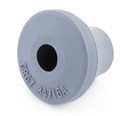
Shown at right: An IP68-rated sealing grommet from Essentra Components. Ideal for high-vibration environments, it has a thin central film that can be pierced to allow a range of different-sized wires to pass through.
2. Reduce Mechanical Stress
Take steps to lessen the impact of mechanical stresses such as vibration, pulling, and bending, which can shorten the life of wires in the harness.
Strain reliefs can help ensure that cables are not subjected to excessive pulling or bending at connection points, which can degrade performance over time. Strain reliefs help maintain long-term electrical integrity and are particularly crucial for areas subjected to frequent flexing, such as doors and liftgates.
Below: Flex nut strain reliefs made of nylon (shown at left) and brass (shown at right), made by Sealcon.
One of the simplest ways to secure wires and prevent excessive movement is by using cable ties. Cable ties come in a variety of options, from standard nylon cable ties that meet UL requirements and are good for general automotive use, to stainless steel cable ties that withstand
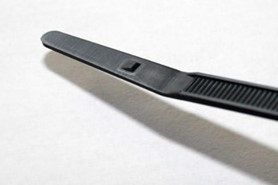 higher temperatures and vibration, and heavy duty cable ties that are ideal for securing heavier-gauge brake, trailer, and battery cables. Learn more in How to Choose Cable Ties for Automotive Use.
higher temperatures and vibration, and heavy duty cable ties that are ideal for securing heavier-gauge brake, trailer, and battery cables. Learn more in How to Choose Cable Ties for Automotive Use.
Right: A close-up showing a “stay tab” feature near the end of an ACT standard cable tie, allowing it to be loosely secured around a bundle and then tightened or released later.
It’s also important to secure the wiring harness properly to the chassis to prevent strain on the wires. Mounting cable ties will allow you to securely fasten wire or cable to a frame, chassis, or paneling with a minimum amount of effort. Mountable loom clips are handy for securing wire or bundles that run through loom.
3-Prevent Moisture and Chemical Intrusion
Harsh environments require wire coverings that offer flexibility and resistance to damage from moisture and chemicals.
One of the most common wire coverings for this purpose is heat shrink tubing. It offers a tight, secure fit around wires and connectors, providing excellent insulation, strain relief, and environmental sealing. Depending on the product, heat shrink will reduce to 50 percent or even 25 percent of its original size once heat is applied.
Single-wall shrink heat shrink provides adequate protection against wear and abrasion in many vehicle applications. For higher performance in corrosion protection and sealing, dual-wall heat shrink with adhesive lining is recommended. Dual-wall heat shrink is ideal for sealing
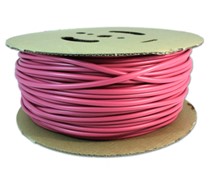 connections in marine, agricultural, and other heavy-duty applications. It contains an internal meltable sealant that physically encapsulates connections to prevent moisture intrusion.
connections in marine, agricultural, and other heavy-duty applications. It contains an internal meltable sealant that physically encapsulates connections to prevent moisture intrusion.
Right: A spool of polyolefin dual-wall heat shrink from DSG-Canusa.
See more details about heat shrink in the article Heat Shrink 101.
Heat shrinkable breakout boots are a great option for securing the point where a group of wires splits off from the main harness into separate branches. The boot is placed over the breakout po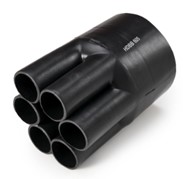 int. When heated with a heat gun, the material shrinks and conforms tightly to the wires and connectors, ensuring a secure, moisture-repelling fit. Some boots also come with adhesive lining, further improving the seal and bond to the wires.
int. When heated with a heat gun, the material shrinks and conforms tightly to the wires and connectors, ensuring a secure, moisture-repelling fit. Some boots also come with adhesive lining, further improving the seal and bond to the wires.
Right: A 6-way heat shrinkable breakout boot from 3M.
Cable glands, such as the one shown below from Thomas & Betts, are another reliable way to seal off cable connection points if the cable is leaving a sealed compartment.
When routing a wire harness, try to avoid areas of extreme heat such as the engine or exhaust system. When hot areas cannot be avoided, you can protect your wire or cable with aluminum reflective sleeving such as the Delfingen sleeving shown at right. Heat radiation coming from the engine, exhaust line or other equipment is reflected by the aluminum surface, while fiberglass braid material delays the increase of temperature inside the sleeve.
Conclusion
Protecting automotive wire harnesses in rugged vehicles is essential for long-term reliability and safety. By selecting the appropriate coverings, reinforcing vulnerable points, and securing harnesses effectively, manufacturers, upfitters, and repair technicians can significantly enhance the durability of their wiring systems. Whether facing high abrasion, extreme temperatures, mechanical stress, or exposure to water or chemicals, taking these protective measures ensures that vehicles remain operational in the toughest conditions.
Subscribe Now
Subscribe and be the first to know when new articles are published.

